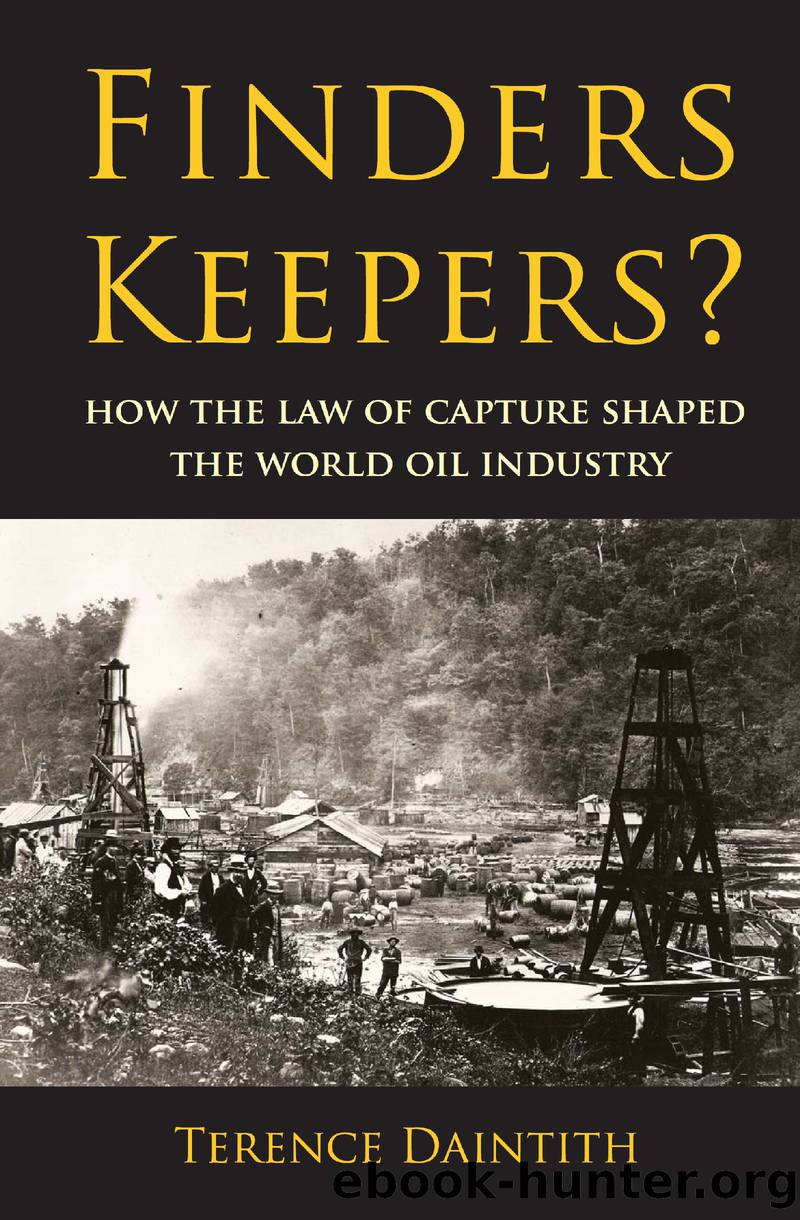Finders Keepers? by Daintith Terence;

Author:Daintith, Terence;
Language: eng
Format: epub
Publisher: Taylor & Francis Group
Published: 2010-08-15T00:00:00+00:00
PRORATIONING OF PRODUCTION
This was the framework within which a divided industry approached its problems of dealing with excessive production and declining demand as the Great Depression overcame the country in 1929. That the industryâs attitudes at such a time should have been driven by a desire to preserve activity and profits rather than protect future generations through improved oilfield practice is hardly surprising, but they are important in explaining the form assumed by conservation measures in the crucial decade of the thirties. Capture was at the root of the problems these measures were trying to address, but the need for quick-acting solutions meant that the approach chosen was one in which the symptoms of the malaise were forcibly suppressed while the underlying sickness went untreated.
That approach was state-by-state restriction of production, and the legal basis on which the industry sought to rest it was the prevention of waste. Oklahomaâs 1915 oil conservation statute conveniently included in its definition âwaste incident to the production of crude oil or petroleum in excess of transportation or marketing facilities or reasonable market demands.â61 Schemes permitting control on this latter basis have been generally referred to as âmarket-demand prorationing.â Not every oil-producing state was prepared to accept market demand as an appropriate basis for production restrictions. The association of the two notions was uncomfortably suggestive of official endorsement of monopolistic price fixing. The Texas statute of 1919 had omitted this basis for control, Louisiana explicitly admitted it only for gas, and California never succeeded in passing any kind of prorationing statute, though it is said to have achieved prorationing âto a limited extentâ by voluntary agreement through the Conservation Committee of California Oil and Gas Producers.62
Whether based on production in excess of market demand or on the risk of some other form of waste, either physical or economic, prorationing involved dividing up the permissible production among producers from a common source. Proration orders were drafted after hearings by the relevant commission, were elaborately reasoned, and reflected considerable input by producers. Indeed, producersâwhere they could agreeâeffectively designed the structures employed. In the first proration order, No. 920 of June 5, 1915, made by the Oklahoma Corporation Commission in relation to the Healdton field, the restrictions were applied by gauging the potential production of each well and reducing its output to the same fraction of that potential as was being applied to the field as a whole.63 Assessing well potentials took time, and some large new fields, like Oklahoma City and later East Texas, were initially prorated simply by dividing the permitted production by the number of wells. Thus, the order for the Oklahoma City field, issued after imposing an initial 30-day shutdown, provided for proration on a âtime basis,â with each well allowed to run wide open for a proportion of a given periodâinitially a weekâcorresponding to the permitted fraction of fieldwide potential. This was initially 40 percent, allowing wells to be run 2.8 days a week; within a year, it was down to 2.75 percent, so that an operator could run its wells for only 8 hours in any 12-day period.
Download
This site does not store any files on its server. We only index and link to content provided by other sites. Please contact the content providers to delete copyright contents if any and email us, we'll remove relevant links or contents immediately.
Second Nature (The Shape-Shifter Series #1) by Jae(1053)
Petroleum Contracts by Peter Roberts(868)
The Global Commons by Susan J. Buck(865)
Infrastructure by Frischmann Brett M(811)
The Monk by Matthew Lewis(791)
Japan Travel Guide: Things I Wish I Knew Before Going To Japan (2019 EDITION) by Fukuyama Ken & Fukuyama Yuki(777)
Ever After by William Wharton(746)
Before Earth Day by Karl Boyd Brooks(716)
Good for You, Great for Me by Lawrence Susskind(709)
War of the Whales by Joshua Horwitz(686)
Biting the Hands that Feed Us by Baylen J. Linnekin(679)
Respecting Animals by David S. Favre(655)
Animal Law in a Nutshell by Frasch Pamela & Hessler Katherine & Waisman Sonia(654)
Uncommon Ground by William Cronon(653)
Rangeland Systems by David D. Briske(643)
After Nature: A Politics for the Anthropocene by Jedediah Purdy(641)
The Ethics of Space Exploration by James S.J. Schwartz & Tony Milligan(633)
Fracking the Neighborhood by Jessica Smartt Gullion(608)
Down to the Wire: Confronting Climate Collapse by David W. Orr(601)
